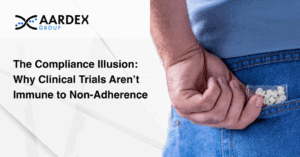The Role of Medication Adherence in Drug Trials
Drug trials are conducted to evaluate the safety and efficacy of new or investigational drugs. The primary goal of drug trials is to determine if a new drug is effective in treating a particular medical condition and if it is safe for use in the general population.
In this context, medication adherence is crucial because it can impact the safety and efficacy of the medication being tested.
When patients are not fully adherent to their medication regimen, it can result in suboptimal exposure to the drug and reduce the ability to accurately measure its safety and efficacy. This can compromise the validity of the trial results and make it difficult to determine the true impact of the medication.
Historically, high adherence rates have been assumed in clinical trials, as it was believed participants would follow the instructions provided to them. However, this assumption is often incorrect, and many studies have shown participants do not adhere to treatment protocols as expected.
Unfortunately, this problem is often overlooked when using outdated and biased methods, such as pill counts, to measure adherence.
For these reasons, medication adherence is an important aspect of drug trials and should be carefully monitored and managed in order to ensure the validity and generalizability of the trial results.
Medication adherence packaging brings new hope in this area, providing a frictionless, non-invasive solution that produces an accurate view of how treatments are used in clinical trials and the effectiveness of drugs in clinical practice.
Sponsors may claim that using medication adherence packaging as a means of monitoring during drug development would hinder approval, as it is expected to be continued in routine practice. However, this assumption is incorrect.
Monitoring adherence during drug development provides valuable insight into how people will actually use the new therapy in real-world conditions. This information allows for the development of safer and more effective dosing schedules that minimize the risk of overexposure to the drug and ensure the safe and effective use of the therapy.
Reducing Variability to Improve Quality
In 2019, the US’ Food and Drug Administration (FDA) published Enrichment Strategies for Clinical Trials to Support Determination of Effectiveness of Human Drugs and Biological Products.1 The industry guidance document suggested how sponsors could reduce variability to improve the quality of their studies.
It describes enrichment as the prospective use of any “patient characteristic to select a study population in which detection of a drug effect is more likely than it would be in an unselected population” and says similar strategies can also be used to enrich safety assessments.
“The enrichment strategies described in (the) guidance are intended to increase the efficiency of drug development and support precision medicine,” it says.
One patient characteristic highlighted by the document is adherence to medication, a long-standing, well-documented challenge in clinical research.
Studies have shown up to 50% of trial participants do not take the drug as set out in the protocol.2 This can drain study power, sometimes even to the point of study failure, and skew safety and efficacy estimations.
The FDA document recommends adherence be encouraged by selecting patients who are more likely to take the therapy as directed and by enhancing medicine-taking behavior.
It also highlights available approaches, including making patients aware of the conditions and demands of the trial and using adherence prompts and alert systems, as well as monitoring drug use “so that non-adherent patients can be encouraged to perform better”.1
Despite this, some researchers are still unsure if and how to deploy medication adherence solutions in their clinical trials.
Adherence is Vital for Safety and Efficacy
Sponsors sometimes assume that any intervention used in a clinical trial must be mirrored in routine practice. By this logic, not being able to guarantee continued use of a medication adherence solution would be an insurmountable barrier to regulatory approval.
It is worth noting, though, that this could not be further from the truth. For instance, the numerous trial visits and associated activities (e.g., pill counting, self-report) are not carried over into the world of clinical practice. The same is true for digital medication adherence solutions.
The central principle of a clinical trial, and the primary duty of a drug developer, is to accurately assess the safety and efficacy of a drug product in the target population and demonstrate that to regulators. Meeting these objectives is challenging, if not impossible, without taking adherence, a significant source of variability, into account.
Currently, many industry players navigate blindly and aim for the highest possible dose in the therapeutic window to compensate for the uncertainties associated with missed doses. Yet this runs the risk of exposing people to unnecessarily high drug levels.
It can lead to toxicity and safety issues, such as exposure-related short- and long-term side effects and adverse events. This can even lead to post-marketing dose reduction or product withdrawal.
If they genuinely want to know how their products will perform in the real world, sponsors need to understand how trial participants take the medication rather than arbitrarily assume a particular adherence level. They also need to understand the barriers to adherence and if and how they can be addressed.
Digital Medication Adherence Solutions
Pill count has been a mainstay of dose tracking for decades, despite a 1989 study concluding that it grossly overestimated compliance,3 a finding reproduced multiple times in the intervening years. Self-report is also inherently subjective, leaving it open to manipulation.
The measurement of drug levels and metabolites is invasive and unreliable, not least because it is subject to the “white-coat adherence” effect, i.e., a short-term escalation in adherence in the days immediately prior to a scheduled clinic visit.4
Fortunately, the emergence of modern approaches, such as the smart pill bottles mentioned in the FDA guidance document, is changing the landscape. This kind of medication adherence packaging can capture dosing events and automatically send the timestamp to medication adherence software.
The software can interrogate the data using sophisticated, proprietary algorithms and flag missed doses or erratic medicine-taking patterns. This information can then be used to risk-stratify participants and guide tailored adherence-enhancing interventions.
Crucially, digital medication adherence solutions have been shown to be 97% accurate.5 As such, it provides sponsors with a holistic view of medicine-taking behavior upon which to base their dosing calculations and predictions of how people will use the therapy in the real world.
In addition, the approach is entirely frictionless for participants. The dosing event is captured automatically, whether that be from the opening of a smart pill bottle or the activation of a pre-filled syringe, meaning the patient needs to do nothing more than take their medicine.
Selecting and Enhancing Adherence
Clinical trials are designed to ascertain the safety and efficacy of a drug product. Still, in the absence of adherence data, sponsors have become used to aiming for unnecessary high doses.
The FDA guidance provides solutions to help sponsors break this pattern of behavior and understand how people take their products during studies. It encourages not just the selection of adherent patients but also enhancing adherence by ensuring participants are conscious of the requirements of the trial, the use of adherence prompts, and utilizing digital health technology tools like medication adherence packaging1.
Not only does this provide a much better idea of how products may be used in real-life settings, but it also provides accurate information on which to base unbiased dosing calculations.
The monitoring of adherence in clinical trials is only impactful if relying on sound or reliable measures. Ultimately, the digital approach, which the FDA has recommended in its enrichment strategies guidance, provides sponsors with a realistic view of their product’s safety and efficacy to present to regulators.
“Research has demonstrated that improving adherence is cost-effective for sponsors,” says Dr. Job van Boven, Associate Professor at the University of Groningen, founding director of the Medication Adherence Expertise Center of the northern Netherlands (MAECON), and chair of the European Network to Advance Best Practices and Technology on Medication Adherence (ENABLE) COST Action.
“While there are costs related to measurement and interventions, these are offset by reduced hospital admissions or avoiding the need to escalate to more expensive drugs. Adherence can be improved to achieve these outcomes, but we must adopt a personalized approach – there is no one-size-fits-all solution.”
References
- US Food and Drug Administration. (2019). Enrichment strategies for clinical trials to support determination of effectiveness of human drugs and biological products guidance for industry. Center for Drug Evaluation and Research (CDER). Available at: https://www.fda.gov/regulatory-information/search-fda-guidance-documents/enrichment-strategies-clinical-trials-support-approval-human-drugs-and-biological-products Last accessed 8 February 2023.
- Eliasson, L., Clifford, S., Mulick, A., Jackson, C., & Vrijens, B. (2020). How the EMERGE guideline on medication adherence can improve the quality of clinical trials. British Journal of Clinical Pharmacology, 86(4), 687-697.
- Pullar, T., Kumar, S., Tindall, H., & Feely, M. (1989). Time to stop counting the tablets?. Clinical Pharmacology & Therapeutics, 46(2), 163-168.
- Podsadecki, T. J., Vrijens, B. C., Tousset, E. P., Rode, R. A., & Hanna, G. J. (2008). “White coat compliance” limits the reliability of therapeutic drug monitoring in HIV-1—infected patients. HIV clinical trials, 9(4), 238-246.
- El Alili, M., Vrijens, B., Demonceau, J., Evers, S. M., & Hiligsmann, M. (2016). A scoping review of studies comparing the medication event monitoring system (MEMS) with alternative methods for measuring medication adherence. British journal of clinical pharmacology, 82(1), 268-279.



